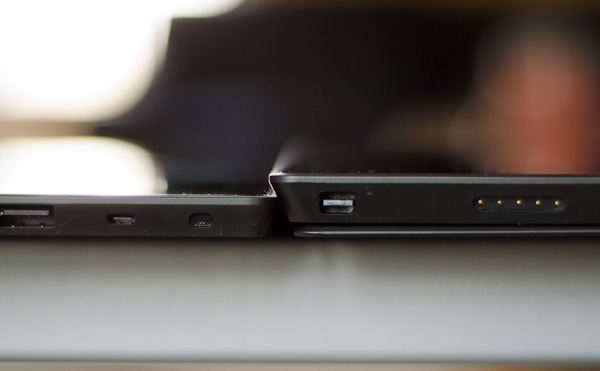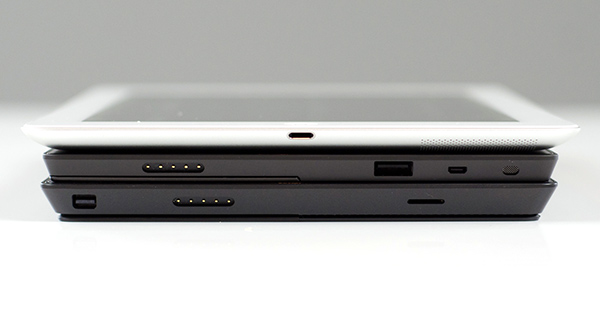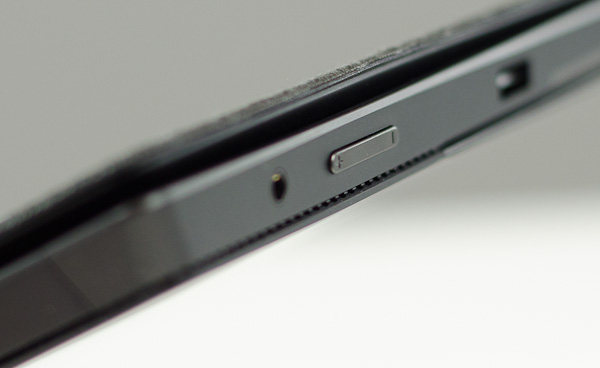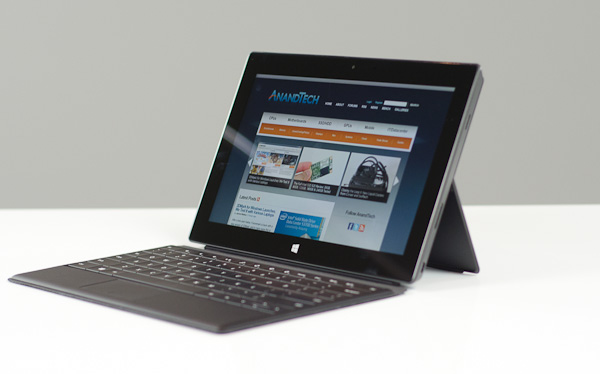Microsoft Surface Pro Review
by Anand Lal Shimpi on February 5, 2013 9:00 PM ESTSurface Pro Design
When I first saw Surface Pro, the Microsoft rep giving me the demo did a simple test. He stood Surface Pro right next to Surface, with the same start screen, and asked me if I could tell the two apart. The planar dimensions of Surface Pro are identical to Surface RT. Both feature the same sized 10.6-inch display, the same capacitive Windows button and the same 1-inch border around the screen. Looking head on, the only way you can tell the difference between Surface Pro and RT is the former’s 1080p display does make text a bit sharper.

Surface RT (left) vs Surface Pro (right)
Turn the two tablets to the side and the differences quickly become evident. Surface Pro is over 40% thicker than Surface RT (13.7mm vs 9.3mm). While the latter was of a similar thickness to an iPad with Retina Display, Surface Pro is clearly in a different league of dimensions.
The thickness of Surface Pro doesn’t really impede its portability, but the weight definitely makes it a lot less pleasant to carry around. Surface RT was already heavier than the competition but it hid its weight well. Surface Pro is just heavy for a tablet. I wasn’t originally impressed by the Surface RT form factor, but in switching between the RT and Pro models I immediately wish that Surface Pro came in the RT chassis and Surface RT came in something even thinner and lighter.

Surface Pro (left) vs. iPad 4 (right)

From top to bottom: iPad 4, Surface RT and Surface Pro
Shift the comparison to Ultrabooks however and all of the sudden Surface Pro seems quite light. It’s lighter than an 11-inch MacBook Air and Acer’s 11.6-inch Aspire S7 (although with optional keyboard cover it is heavier). It’s all about perspective. Compared to an iPad, Surface Pro is heavy, but compared to an Ultrabook or MacBook Air it’s light. The Pro model embodies the vision Microsoft had for the Surface family: to create a new type of device somewhere between a tablet and a notebook. That’s not to say there’s not room for improvement in the physical department. Surface Pro will likely go on a diet as it’s given more power efficient silicon, but even then you’ll always be able to build something thinner and lighter based on slower hardware, or go thicker and heavier with a notebook.
The fit and finish of Surface Pro are just as good as Surface RT. The tablet is built out of the same injection moulded Magnesium process (VaporMg) as Surface RT, however the chassis itself is somewhat simplified. While Surface RT featured three discrete VaporMg components (frame, back and kickstand), Surface Pro is made up of only two (single piece frame+back and kickstand). The result is no different to the end user, but the simplification on the assembly side is likely better for Microsoft.
I am fine laying the same praise on Surface Pro’s build quality as I did on Surface RT. The unique finish doesn’t feel like the aluminum we’re used to seeing on iPads, and definitely feels better than the plastic we’ve seen elsewhere. The VaporMg surface doesn’t feel like it would scratch easily, and after a few months with Surface RT I don’t see any visible scratches on my unit.
Surface Pro’s construction feels more utilitarian and understandably more oriented towards productivity, just like its little brother. I still believe that the Surface lineup is as much about Microsoft showing that it too can build high quality devices as it is about getting into the tablet market. If we compare it to the iPad, Surface Pro feels just as well built, if we compare it to every Windows RT and Windows 8 tablet or notebook on the market today - it’s worlds better. Say what you will about Microsoft entering the PC hardware business, but as of today Microsoft builds the best Windows RT and Windows 8 hardware on the market. If I ran a PC OEM I wouldn’t be angry at Microsoft, I’d be angry at myself for letting this happen.
Surface Pro retains the integrated kickstand from Surface RT, although the kickstand has been beefed up to accommodate the heavier tablet. Surface Pro’s kickstand keeps the device propped up at a fixed angle of 26-degrees away from the vertical axis. The rear facing camera is also angled to compensate (it shoots parallel to the ground with the kickstand opened).
The kickstand is allegedly good for over a million open/close cycles and it still doesn’t feel like something that would break. There are only two hinges in the kickstand compared to three for the RT model.
The kickstand on Surface Pro feels different than the kickstand on Suface RT. The Pro kickstand feels lighter and sounds less like metal and more like plastic if you tap on it. Feel around on the underside of the kickstand and you’ll notice a coating that seems to dampen sound and perhaps add some structure reinforcement to the design. Microsoft had to thicken the kickstand to support the added weight of the Surface Pro, but the difference is on the order of a fraction of a millimeter.
The tweaked kickstand does have different acoustics than Surface RT’s kickstand. While the latter sounded a lot like a thin metal door shutting, the Pro’s kickstand is far more muffled. I’d almost say it’s preferable.
Thankfully the kickstand’s functionality hasn’t been marginalized in the transition to the Pro. It’s still a highly integrated and very important part of the Surface experience. It’s simple to flip out and perfect for use on desks. You can make the kickstand work on your lap or chest if you’re lying down, but it’s not ideal for either unfortunately.
The more I use Surface (Pro and RT) the more I feel that Microsoft needs to pursue something a bit more flexible than the fixed 26-degree kickstand. The biggest issue by far is in-lap use with one of the keyboard covers attached. Depending on your seating position, the 26-degree angle that the kickstand opens at might be too small. Mechanically I don’t know the right solution for Microsoft but I do feel like for the kickstand to realize its true potential, it needs to be able to open and hold at multiple angles. It doesn’t necessarily need to have support for infinite angles, maybe even a few would work, but I do believe it’s necessary going forward.













228 Comments
View All Comments
maximumGPU - Wednesday, February 6, 2013 - link
it might not be the best of both worlds but for a lot of poeple it beats carrying a laptop AND a tablet.LetsGo - Wednesday, February 6, 2013 - link
But you can't use it in your Lap so its rubbish as a laptop, and you can't use it as a tablet because its too heavy. so really its a portable desktop replacement with a digitizer.amdwilliam1985 - Wednesday, February 6, 2013 - link
It really depends on your point of view, what you see as shortcoming is exactly opposite of what I have in mind. I guess everyone has different needs, and NO one size fits all, of course unless you're iSheep, then one size does fit all.Anyway, I would love to give up my Samsung Galaxy S3(4.8" screen) and Google Nexus 7(7" screen) for the upcoming Galaxy Note 3(rumored 6.3" screen).
*YES, I will be holding it next to my face to make phone calls, I'm already doing it on my Nexus 7 with wifi-calling.
*YES, I can do it next to those iTiny with 3.5" or 4.0", so they can laugh at me, or I can laugh at them, lol.
*YES, I am able to fit it into my pocket, I am currently carrying both S3 and N7 in my pockets.
*NO, I do not have oversize pockets, they can easily fit into my work trouser and my jeans.
*NO, I do not care about your opinion of me.
*YES, I believe you over care about what other people thinks.
"It's amazing that some people will do anything to 'fit in' while others will do everything to 'fit out'". -some "wise" guy
beginner99 - Wednesday, February 6, 2013 - link
Considering the hardware the price makes sense but it just feels too expensive. For $999 I expect the full type cover at least.The best thing about this is the USB port on the power brick. So you can live with 1 charger and leave the one for smartphone, eReader and other gadgets at home like when you go on vacation.
Jaerba - Wednesday, February 6, 2013 - link
Thanks for the great review, Anand. It confirmed my worries about the battery life and kickstand/lap usability, so I'm wondering if there's a possible battery keyboard dock on the horizon, like the Helix or Transformer Prime have. Can you even do power transfer through the magnetic clip?It seems like that one accessory would fix all of the major issues.
Byte - Wednesday, February 6, 2013 - link
Been waiting for this since my compaq tc1000. awesome screen, but one q, is it big enough to be able to play starcrft2? Not sur ehow ivy handles sc2 but I'm hoping haswell will be able to handle it.althaz - Wednesday, February 6, 2013 - link
Yes it plays Starcraft 2. I have played SC2 on identical hardware and it works fairly well, obviously you'll not be playing on High or Ultra settings.This is one of the reasons I'm picking one up as soon as is humanly possible. Portable Starcraft machine? Check. Football Mananger PC on the train? Check. Angry Birds/web-browsing from the couch? Check. Can run visual studio and photo shop? Check.
Winner! (I don't care about battery life past 2-3 hours and find the weight quite acceptable, ymmv).
tdtran1025 - Wednesday, February 6, 2013 - link
So it's the fastest tablet out there, but for what? RT is sluggish, Windows 8 did not take off like MS expected it to, what else is there? Maybe XBox 720 will rescue MS.amdwilliam1985 - Wednesday, February 6, 2013 - link
RT will be fine when they get tegra 4 or Snapdragon S4 pro in the next iteration along with more apps.Windows 8 is doing just fine, they're having decent market shares, I also bought a copy for my 5 years old (athlon x2 @ 2.5ghz) and it works great :)
I do plan on getting that awesome Lenovo Yoga to take full advantage of touch.
MS has more than xbox, they have the heart of business world.
The world can live on if suddenly facebook or Apple cease to exist, but the world will crumble if Google or MS falls. Just my 2 cents, probably why Apple(fashion) stocks UPs and DOWNs like crazy, because it can easily be replaced.
Simple test here, imagine tomorrow morning if your iphone/ipad/ipod ceased to exist, huh, just pick up some other replacements. Now imagine, tomorrow windows ceased to exist, lol, god forbid.
duploxxx - Wednesday, February 6, 2013 - link
Scrolling in web pages, application install time, file copy time, everything is just significantly faster on Surface Pro than on any competing tablet. Oh, and it boots (from full power off) in less than 10 seconds. It’s really the combination of the great CPU performance and fast SSD that deliver the responsiveness of the Surface Pro.cpu performance that's all nice, questionable if it is really needed vs the reduced battery life, you get, higher cost, weight and size. but anyhow.
NO GPU performance benchmarks? Is it really usable with the downscaled GPU ghz, typical issues with even general adobe flash games crashing with these kind of gpu, afterall that is where some of these tablets end up, a kid playing on internet games....